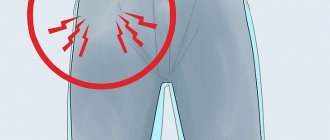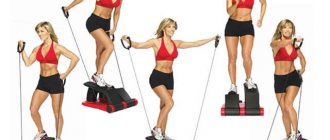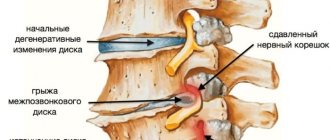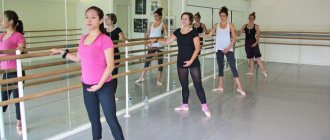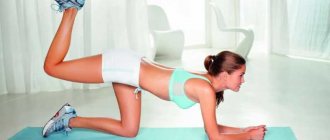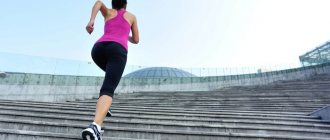Author: Timko Ilya - the ruler of the entire site and fitness trainer | more details >> Rod. 1984 Trained since 1999 Trained since 2007. Author and creator of the site tvoytrener.com. CCM in powerlifting. Champion of Russia and South Russia according to AWPC. Champion of the Krasnodar region according to IPF. 1st category in weightlifting. 2-time winner of the Krasnodar Territory championship in t/a. Author of more than 700 articles on fitness and amateur athletics. Author and co-author of 5 books.
Place in the author rating:
out of competition
(become an author) Date: 2019-07-03 Views: 58,114 Rating: 4.8
| All articles by the author >> | Medals articles >> |
Articles are loading...
Stretching exercises for splits for beginners
httpv://www.youtube.com/watch?v=embed/G4lTnj2LW5s
So how do you know how flexible you are? The answer is obvious - of course, twine! Don't panic ahead of time. I promise that you will slowly and confidently sit in this pose. Try the five stretches I suggest below!
Forward bends
Stand straight, feet together, arms at your sides. Stretch your arms forward, raise them above your head, then stretch your chest and arms down. Let your fingers or palms slide down your legs and then slowly pull your chest toward your knees. If you have difficulty reaching your toes, bend your knees slightly until you can touch the floor with your toes. Reach your chin and chest toward your knees and hips for maximum stretch. Remember to keep your knees together and slightly bent to avoid injury.
Stretching the hips and back relieves anxiety, relieves headaches, improves digestion and clears the mind.
Pyramid pose
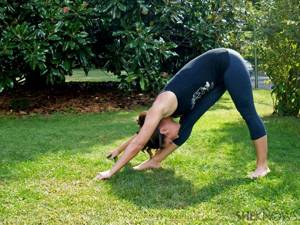
Start in tadasana or mountain pose (stand straight, legs together, arms at your sides), one foot apart from the other at a distance of 90-120 cm, foot slightly turned outward, heel of the exposed leg facing the heel of the supporting leg
Note: It is important that your feet are not in line. The back leg should be moved back a few centimeters to maintain balance.
Once you have your feet positioned correctly, slide your toes down your front leg and lower your chest toward your hip. Reach your toes forward of your front leg for a greater stretch.
The back, shoulders, wrists, hips are stretched and the legs are strengthened. Posture and balance improve, and the brain calms down.
Lizard pose
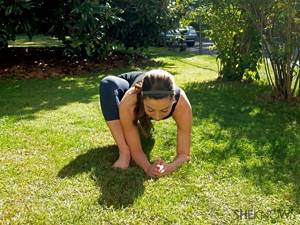
Do a low lunge with your supporting leg bent (knee forward), knee bent so that it is level with your ankle, and your other leg extended back. The knee of the leg that is behind you is lowered to the floor, in a relaxed state; stretch your arms out in front of you.
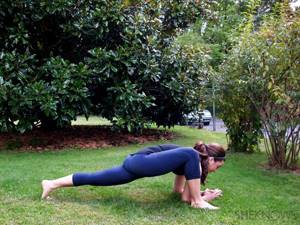
From this position, begin to reach towards the floor, leaning on your forearms and bending your chest towards the floor, the head and heel of the leg that is behind you stretching back. You can add variety to this pose by placing something under your arms.
Stretches the hips, hamstrings, groin, abdominal muscles, shoulders and neck. The chest and lungs open.
Pigeon pose
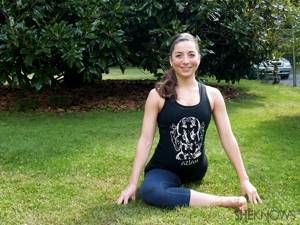
In a seated position, extend your right knee while resting on one leg. Next, rotate your knee so that it points toward your right wrist and your ankle toward your left, making sure to keep your shin parallel to the floor or mat.
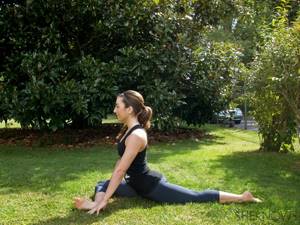
Lower your hips and torso toward the floor, stretching your left leg, which is extended back. If this is too painful or uncomfortable, pull your right ankle toward your body to loosen the ligaments slightly.

Once you are comfortable, reach forward with your fingertips and lower your chest towards the floor.
The hips, groin, abdominal, chest, shoulder and neck muscles are stretched. The abdominal organs are stimulated. The chest and shoulders open.
Walking Pose

Sit down, stretch your legs in front of you, arms behind your back, spread your legs as wide as possible. From this position, place your hands in the free space in front of you, stretch them forward until you feel that you cannot go any further.
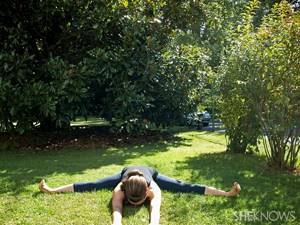
Once you have reached your maximum, try to bend your chest and head towards the floor.
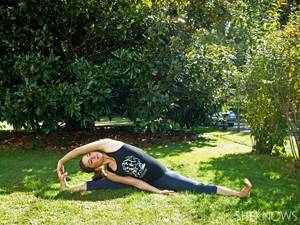
It is also helpful to stretch each leg separately while in this pose. To do this, reach over your head with your left hand towards your right leg, trying to reach your toes with your fingers. Hold this position for 8 breaths.
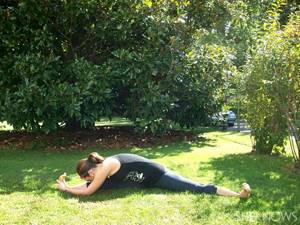
Then, turn your head and chest so that your torso is facing your right leg and reach your nose towards your knee. Again, hold this position for 8 breaths, and then repeat the same for the other leg.
The back, inner and back of the legs are stretched. The organs in the abdominal cavity are stimulated. The groin area relaxes.
A few minutes spent stretching in the morning will help you stay energized throughout the day.
If you're interested in starting your day feeling energized, try a few of the muscle stretches suggested by Dr. Matthews. Perform each exercise for 30 seconds, repeat this cycle for a 4-minute workout. In the morning, you may feel that some areas of your body are a little tense, so take time to warm up those muscles. Listen to your body, work in a range of motion that suits you, Matthews advises.
A quick morning stretching session is a great way to relax your body and prepare it for the day ahead. You won't need to set your alarm half an hour or an hour earlier. You don't even need to go outside to do this. If you wish, you can take a couple of sips of fresh coffee between individual exercises.
“We walk a lot”: Asmus told with whom and how she spends the New Year holidays
The dacha is a cultural heritage: a Swiss journalist visited dachas near Moscow
Detailed review of the 2021 Honda Odyssey: a crossover minivan for a large family
Exercises demonstrated by: Crystal Williams, a group fitness instructor and trainer who practices in commercial gyms and at home throughout New York City; Caitlin Seitz, songwriter, singer and New York-based fitness instructor in the bands; Shanna Tyler, yoga instructor in New York City; Rachel Denis is a competitive American powerlifter and holder of multiple powerlifting records in New York State.
The benefits of cross twine
The benefit of cross splits is not only the effect it produces on others, but also some positive changes for the body. It is worth mastering for those who want to make their legs slim, improve their posture and strengthen their abs.
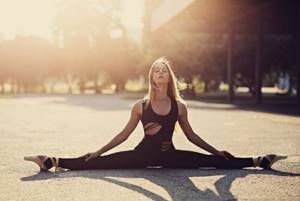
Cross twine also has other positive consequences:
- increasing the elasticity of the muscles of the perineum and pelvis helps improve blood circulation in the organs of the genitourinary system and prevents the occurrence of stagnation in them;
- stretching during cross splits and involving the abdominal muscles in the process improves the functional state of the digestive organs and prevents the occurrence of disturbances in the gastrointestinal tract;
- good mobility of the hip joints makes it easier to perform strength and anaerobic exercises - the amplitude becomes greater, the quality of performance increases.
Cross splits are especially useful for girls. Good stretching and improving the elasticity of the ligaments and muscles in the perineum and lower back improves well-being during pregnancy and facilitates the birth process.
As for the disadvantages and harms of cross twine, they were an increased risk of injury - sprain and rupture of ligaments, and sometimes muscles. However, only those athletes who decide to achieve results quickly without long training encounter them. Therefore, if you want to do the cross splits, you should be prepared for slow progress towards the goal and daily training.
A little theory
Before you start stretching, it is advisable to familiarize yourself with the anatomy of our body and find out which muscles and ligaments are stretched during exercise, what processes occur in the body, and what features the human body has. Knowing all these nuances, you can most effectively influence your muscles.
In addition to muscles, stretching also involves fascia (a special “case” in which each muscle is enclosed), tendons and joints. Some of them stretch, others do not, but have “tolerance” to stretching or are able to open.
Before you start doing stretching exercises at home that will help you do the splits, let's get acquainted with some anatomical features of the body.
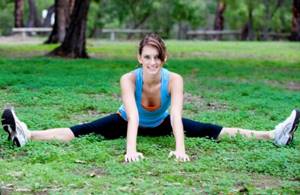
Muscles:
- when stretched, the muscle lengthens due to the fact that it grows new segments in its structure. This is a gradual process, so stretching should be gradual so as not to get injured. You also need to do a warm-up before each session - it makes the muscles more flexible and warms them up, making them more susceptible to stretching;
- Strong and trained muscles stretch best. If you have been doing strength exercises and have an athletic body, then it will be easier for you to do the splits. In addition, strong muscles also prevent overstretching and tearing of tissues, making exercises safe;
- The connective tissue in muscle fibers is made of collagen, just like joints and tendons. The ability of a muscle to stretch directly depends on the elasticity of the connective tissue caused by collagen fibers.
Find out how to protect ligaments and joints with collagen and what to do if your muscles hurt after a workout.
Important! To increase the flexibility of the body during training, you can drink a drug with collagen.
Fascia:
- a kind of “bag” in which the muscle is enclosed and which limits its growth and gives it shape. It stretches poorly, but is able to remember its shape;
- with age, fascia tends to contract and restrict muscles;
- constant muscle tone and static tension (for example, due to stressful work or a sedentary lifestyle) lead to contraction of the fascia;
- It is possible to stretch the fascia without prior strength training, but this is a long process. Fascia stretches and grows best when performing strength exercises, when blood flows to the muscles. It is the blood supply that promotes the growth of fascia.
Joints and tendons:
- the joints do not stretch at all, and the ligaments and tendons only acquire “tolerance” to stretching, that is, they become capable of withstanding a large range of movements and stretching without injury, and become elastic;
- the joints do not stretch, but open, and this occurs due to the “stretched” ligaments, which allow the joint to come into a state of opening;
- The greatest opening during splits, especially transverse, is required by the hip joints, while they are the ones that are most susceptible to opening in the human body;
- not all people have the inclination to do the splits, since due to the individual structure of the hip joints, opening is simply impossible. But don't despair, this is not a common case.
Important! There are joints that must not be opened! These are the elbow, knee and cervical: the function of these joints is to provide reliable fixation and mobility, and opening them will make them unstable, which will lead to many problems.
A few more facts about the flexibility of the human body to know how to learn to do the splits at home:
- Men and women have different tendencies towards flexibility - women are naturally more flexible, while men are more inclined to build muscle mass;
- not all joints are equally prone to opening: if one joint opens well, others may be more static;
- large muscle mass is an obstacle to stretching. And vice versa - weak, stretched muscles are prone to injury. The best option is to simultaneously pump the muscles and stretch them, for example, as in athletics. Ideally, you will train your body with strength exercises and stretch it;
- There is a certain range of flexibility to which a person is inclined. Of course, there are people who are able to go beyond this range, but this is facilitated by an innate tendency to flexibility and intense exercise from early childhood. However, most people cannot stretch more than is allowed by nature.
Dynamic stretching will help awaken your body.
"Stretching in the morning, especially dynamic exercise, can be a great way to gradually wake up your body and brain after a restful night and prepare it for whatever the day has in store," says Jessica Matthews. Jessica is a PhD in mental health, a professor in the Department of Kinesiology (the science of muscle movement) at Point Loma Nazarene University in San Diego, USA, and a certified yoga instructor, as well as the author of The Striving for Youth.
To achieve a quick invigorating effect, it is necessary to perform exercises with dynamic muscle stretching - that is, exercises during which movements are carried out within the functional range at a controlled speed. These exercises are different from static stretching, where specific muscles are stretched and remain stretched for a period of time. Dynamic movements with stretching are ideal for awakening your body.
HomePod mini has been updated and now supports 18W charging
Following the students, teachers and tutors appeared on TikTok: does this make sense?
Lazarev and Topalov plan to record a joint track for the 20th anniversary of Smash
“Dynamic stretching is a kind of “rehearsal” during which the nervous system and muscles (neuromuscular system) are prepared to work together effectively. This could be preparation for physical training or any type of physical activity, Matthews continues. – Stretching in the morning can also improve your ability to control your body and help you remember exercise patterns that are beneficial to your health, such as getting your heart pumping and squeezing your shoulder blades together before performing overhead strength exercises. This, in turn, increases the effectiveness of exercise both in the sports hall and in the fresh air.”
What else is worth knowing?
Once upon a time, ease of movement and mobility seemed completely natural to us.
In this regard, don’t you think that splits are something from childhood? Although, probably not, since you are reading this article. And you're right. Years later, we don’t want to give up, but nothing proves our youth more indisputably than elastic, trained muscles and flexible joints.
Important points
It may very well be that now this task seems overwhelming to you. However, you can always configure yourself so that such a situation only adds excitement.
The main ones, of course, are your perseverance and perseverance. Next, perhaps, we will name age, but we will not exaggerate its significance. Even though you are already well over 40, after 2-3 weeks of constant training you will, even with some disbelief, begin to notice how much easier your movements have become. The number of years only slightly lengthens the path to achieving what you want.
Regularity of training
Like no other athletic task, great stretching requires regularity. The muscles quickly return to their original state. Therefore, how to learn to do the splits if you are lazy? After all, then you will have to constantly start all over again. Ideally, you should not miss a single day. However, the intensity of training may vary.
Moreover, when you start training, you will discover: the muscles do not always behave the same way - sometimes they respond easily to exercise, sometimes they practically refuse to obey. Don't force yourself too actively. Let it be a little careless, but it will happen.
Class time
By evening, the muscles will automatically warm up well from the whole day, and the exercises will be easier. However, don't use this fact as an excuse if morning time is more convenient for you. You just need to warm up better. And if you are interested in how to quickly learn how to do the splits, you need to know some details.
Pain
How can you learn to do the splits without it? After all, pain is an indicator that changes are actually happening in your muscles.
Important: it should not be sharp, but not strong, dull, tugging. If it does happen that you experience acute discomfort, exercise should be stopped immediately and resumed only after the discomfort has disappeared. A common mistake
Common Mistake
While stretching, it is very tempting to keep your back and knees bent. Of course, it’s more comfortable this way! Try not to give in to temptation, warns hudeem-bez-problem.ru, otherwise there will be no effect - the necessary muscles simply will not engage in work.
Effective stretching exercises
Warm-up
Only with a good warm-up will you understand how to learn to do the splits without injury. Walking, running, jumping, squats, straight leg swings are the best preparation for stretching. In addition, it is necessary to stretch the joints by performing rotational movements in the knees and ankles.
Lunges
One leg, bent at the knee, is in front, the other, fully straightened (!), is set back. We perform springy movements - from 10 or more, depending on the condition. Then we change the legs accordingly. Over time, the exercise can be complicated by moving the back leg further and further.
Side lunges and rolls
With your legs spread wide apart, take one of them to the side and sit down on the other. We spring again, focusing on the bent leg and stretching the straightened one. From 10 times on each leg.
Butterfly wings
In a sitting position, we spread our knees to the sides as much as possible, and bring our feet together. Again we gently spring, aiming our knees towards the floor, lightly pressing on them with our hands. We perform from 30 movements.
Bends while standing and sitting
The goal is to be able to press your chest to your knees. This is what we strive for. Don't forget about straight knees and back! We fix ourselves in the maximum possible tilt for as long as possible, and so on 3-4 times.
Leg-split
Of course, this is not a split as such, but rather an intermediate stage. We pull one straight leg forward, the other back and try to stay in the lowest position for at least a minute. Stretching the muscles, slightly sway up and down. It's better to do 2 or 3 approaches.
httpv://www.youtube.com/watch?v=embed/3T39p3l9Cvo
Morning stretching: how to do it right
INSTRUCTIONS
on the use of a medicinal product for medical use
Nise®
Registration number: P N012824/03
Trade name of the drug : Nise®
International nonproprietary name of the drug: nimesulide.
Dosage form: tablets
Compound
Each tablet contains:
Active ingredient: nimesulide 100 mg.
Excipients: calcium hydrogen phosphate, microcrystalline cellulose (type 114), corn starch, sodium carboxymethyl starch, magnesium stearate, colloidal silicon dioxide, talc.
Description
White with a yellowish tint, round biconvex tablets with a smooth surface.
Pharmacotherapeutic group: non-steroidal anti-inflammatory drug (NSAID).
ATX code: M01AX17.
Pharmacological properties
Pharmacodynamics
Non-steroidal anti-inflammatory drug (NSAID) from the sulfonanilide class. Is
a selective competitive inhibitor of cyclooxygenase-2 (COX-2), inhibits the synthesis of prostaglandins at the site of inflammation. The inhibitory effect on COX-1 is less pronounced (less likely to cause side effects associated with inhibition of prostaglandin synthesis in healthy tissues). Has anti-inflammatory, analgesic and pronounced antipyretic
action.
Pharmacokinetics
Absorption when taken orally is high (food intake reduces the rate of absorption without affecting its degree). Time to reach maximum concentration (TCmax) - 1.5-2.5 hours. Communication with plasma proteins - 95%, with erythrocytes - 2%, with lipoproteins - 1%, with acidic alpha1-glycoproteins - 1%. Changing the dose does not affect the degree of binding. The maximum concentration value (Cmax) is 3.5-6.5 mg/l. Volume of distribution – 0.19-0.35 l/kg. Penetrates into the tissues of the female genital organs, where after a single dose its concentration is about 40% of the concentration in plasma. Penetrates well into the acidic environment of the inflammation site (40%) and synovial fluid (43%). Easily penetrates histohematic barriers.
Metabolized in the liver by tissue monooxygenases. The main metabolite - 4 - hydroxynimesulide (25%), has similar pharmacological activity, but due to a decrease in the size of the molecules, it is able to quickly diffuse through the hydrophobic channel COX - 2 to the active binding site of the methyl group. 4 - hydroxynimesulide is a water-soluble compound, the elimination of which does not require glutathione and conjugation reactions of phase II metabolism (sulfation, glucuronidation, etc.).
The half-life (T1/2) of nimesulide is 1.56-4.95 hours, 4 - hydroxynimesulide - 2.89-4.78 hours.
4—Hydroxynimesulide is excreted by the kidneys (65%) and bile (35%) and undergoes enterohepatic recirculation.
In patients with renal failure (creatinine clearance 1.8-4.8 l/h or 30-80 ml/min), as well as in children and the elderly, the pharmacokinetic profile of nimesulide does not change significantly.
Indications for use
- rheumatoid arthritis;
- articular syndrome during exacerbation of gout;
- psoriatic arthritis;
- ankylosing spondylitis;
- osteochondrosis with radicular syndrome;
- osteoarthritis;
- myalgia of rheumatic and non-rheumatic origin;
- inflammation of ligaments, tendons, bursitis, including post-traumatic inflammation of soft tissues;
- pain syndrome of various origins (including in the postoperative period, with injuries, algodismenorrhea, toothache, headache, arthralgia, lumbar ischialgia).
The drug is intended for symptomatic therapy, reducing pain and inflammation at the time of use, and does not affect the progression of the disease.
Contraindications
Hypersensitivity to the active substance or auxiliary components; complete or incomplete combination of bronchial asthma, recurrent polyposis of the nose or paranasal sinuses and intolerance to acetylsalicylic acid and other NSAIDs (including a history); erosive and ulcerative changes in the mucous membrane of the stomach and duodenum (duodenum), active gastrointestinal bleeding, cerebrovascular or other bleeding; inflammatory bowel diseases (Crohn's disease, ulcerative colitis) in the acute phase; hemophilia and other bleeding disorders; decompensated heart failure; liver failure or any active liver disease; anamnestic data on the development of hepatotoxic reactions when using nimesulide preparations; concomitant use of potentially hepatotoxic substances; alcoholism, drug addiction; severe renal failure (creatinine clearance less than 30 ml/min), progressive kidney disease, confirmed hyperkalemia; period after coronary artery bypass surgery; pregnancy, lactation period; children under 12 years of age (for this dosage form, see the “Special Instructions” section).
Carefully
Coronary heart disease, cerebrovascular disease, congestive heart failure, dyslipidemia/hyperlipidemia, diabetes mellitus, peripheral arterial disease, smoking, creatinine clearance less than 60 ml/min. Anamnestic data on the development of ulcerative lesions of the gastrointestinal tract, the presence of Helicobacter pylori infection, old age, long-term use of NSAIDs, frequent alcohol consumption, severe somatic diseases, concomitant therapy with anticoagulants (for example, warfarin), antiplatelet agents (for example, acetylsalicylic acid, clopidogrel), oral glucocorticosteroids ( for example, prednisolone), selective serotonin reuptake inhibitors (for example, citalopram, fluoxetine, paroxetine, sertraline).
Directions for use and doses
The minimum effective dose should be used for the shortest possible short course. The tablets are taken with enough water, preferably after meals.
Adults and children over 12 years old - 1 tablet orally 2 times a day. If you have diseases of the gastrointestinal tract, it is advisable to take the drug at the end of a meal or after a meal. The maximum daily dose for adults is 200 mg.
Patients with chronic renal failure require a reduction in the daily dose to 100 mg.
Side effect
The frequency of side effects is classified depending on the frequency of occurrence: often (1-10%), sometimes (0.1-1%), rarely (0.01-0.1%), very rarely (less than 0.01%) , including individual messages.
Allergic reactions: rarely – hypersensitivity reactions; very rarely - anaphylactoid reactions.
From the central nervous system: infrequently – dizziness; rarely - a feeling of fear, nervousness, nightmares; very rarely - headache, drowsiness, encephalopathy (Reye's syndrome).
From the skin: infrequently – itching, rash, increased sweating; rarely: erythema, dermatitis; very rare: urticaria, angioedema, facial swelling, erythema multiforme, including Stevens-Johnson syndrome, toxic epidermal necrolysis (Lyell's syndrome).
From the urinary system: infrequently - swelling; rarely - dysuria, hematuria, urinary retention, hyperkalemia; very rarely - renal failure, oliguria, interstitial nephritis.
From the gastrointestinal tract: often – diarrhea, nausea, vomiting; infrequently – constipation, flatulence, gastritis; very rarely - abdominal pain, stomatitis, tarry stools, gastrointestinal bleeding, ulcer and/or perforation of the stomach or duodenum.
From the liver and biliary system: often - increased “liver” transaminases; very rarely - hepatitis, fulminant hepatitis, jaundice, cholestasis.
From the hematopoietic organs: rarely – anemia, eosinophilia; very rarely - thrombocytopenia, pancytopenia, purpura, prolonged bleeding time.
From the respiratory system: infrequently – shortness of breath; very rarely - exacerbation of bronchial asthma, bronchospasm.
From the senses: rarely – blurred vision.
From the cardiovascular system: infrequently – arterial hypertension; rarely – tachycardia, hemorrhages, “hot flashes”.
Other: rarely – general weakness; very rarely - hypothermia.
Overdose
Symptoms: apathy, drowsiness, nausea, vomiting. Gastrointestinal bleeding, increased blood pressure, acute renal failure, and respiratory depression may occur.
Treatment: The patient requires symptomatic treatment and supportive care. There is no specific antidote. If an overdose has occurred within the last 4 hours, it is necessary to induce vomiting, take activated carbon (60–100 g per adult), and osmotic laxatives. Forced diuresis and hemodialysis are ineffective due to the high binding of the drug to proteins.
Interaction with other drugs
The effect of medications that reduce blood clotting is enhanced when used simultaneously with nimesulide.
Nimesulide may reduce the effect of furosemide. Nimesulide may increase the possibility of side effects while taking methotrexate.
Plasma lithium levels increase when lithium and nimesulide are taken simultaneously.
Nimesulide may enhance the effect of cyclosporine on the kidneys.
Use with glucocorticosteroids and serotonin reuptake inhibitors increases the risk of gastrointestinal bleeding.
special instructions
Since Nise® is partially excreted by the kidneys, its dose should be reduced in patients with impaired renal function, depending on creatinine clearance.
Given reports of visual disturbances in patients taking other NSAIDs, treatment should be stopped immediately if any visual disturbance occurs and the patient should be examined by an ophthalmologist .
The drug can cause fluid retention in tissues, so patients with high blood pressure and cardiac problems should use Nise® with extreme caution.
Patients should undergo regular medical monitoring if they, along with nimesulide, take medications that are characterized by an effect on the gastrointestinal tract.
If signs of liver damage appear (itching, yellowing of the skin, nausea, vomiting, abdominal pain, dark urine, increased levels of liver transaminases), you should stop taking the drug and consult your doctor.
The drug should not be used simultaneously with other NSAIDs.
The drug can change the properties of platelets, but does not replace the preventive effect of acetylsalicylic acid in cardiovascular diseases .
The use of the drug may adversely affect female fertility and is not recommended for women planning pregnancy.
After 2 weeks of using the drug, monitoring of biochemical indicators of liver function is necessary.
This dosage form is contraindicated for children under 12 years of age, but if it is necessary to use nimesulide in children over 7 years of age, dispersible tablets 50 mg and suspension can be used in strict accordance with the instructions for medical use attached to them.
Since the drug can cause drowsiness, dizziness and blurred vision, care must be taken when driving vehicles and engaging in other potentially hazardous activities that require increased concentration and speed of psychomotor reactions.
Release form
Tablets, 100 mg.
10 tablets in a PVC/aluminum blister. 1, 2, 3 or 10 blisters along with instructions for use in a cardboard pack.
Storage conditions
In a place protected from light at a temperature not exceeding 25 ° C.
Keep out of the reach of children!
Best before date
3 years.
Do not use after the expiration date stated on the packaging.
Conditions for dispensing from pharmacies
On prescription.
Manufacturer
Dr. Reddy's Laboratories Ltd., India
Dr. Reddy's Laboratories Ltd., India
Names and addresses of production sites of the drug manufacturer
- Manufacturing Unit-II, Plot No. 42, 45 and 46, Bachupally Village, Kutubullapur Mandal, Ranga Reddy District, Telangana, India.
- Manufacturing Unit - 6, Khol Village, Nalagarh Road, Baddi, Solan District, HP, 173205, India.
Send information about complaints and adverse drug reactions to:
Representative office:
115035, Moscow, Ovchinnikovskaya embankment, 20, building 1
tel
Fax
How to do the splits in 2 months
At any age it is nice to have a strong, beautiful and flexible body. But good stretching also means freedom of movement, good blood circulation, and a reduced risk of injury not only when playing sports, but also in everyday life.
Well-developed muscles age more slowly and help joints maintain mobility. This is especially true for the hips
This is why in many types of fitness, from stretching to bodybuilding, the ability to do the splits is so important.
Basic split stretch
The ability to do the splits is most often acquired through long and, what is important, correct training, because if you try to spread your legs wide to the sides without preparation, there is a risk of getting a sprain or even micro-tears of the muscles. If you set a goal to do the splits: longitudinal or, especially, transverse, coaches advise approaching the result gradually
Warm-up exercises:
- running in place. Alternate 2 minutes of regular running with 1 minute of running with hip raises;
- squats. 2 sets of 10 repetitions of deep squats and 2 of the same sets of incomplete ones are excellent preparation for intense exercises;
- Jumping rope is a classic for any warm-up. 100-200 jumps at a comfortable pace;
- swing your legs. This final stage of the warm-up will prepare the thigh muscles. You need to stand up straight and, without allowing the body to move above the lower back, alternately perform 10-15 swings of the left and right legs in the forward-backward-sideways directions. To further stimulate blood circulation, it is recommended to massage your feet.
Now you can start the exercises.
The best split exercises
As already mentioned, you should not immediately try to take the desired position, that is, completely sit in a deep split. For beginners, it is better to fix the maximum achievable position and slowly, lesson by lesson, improve the result.
The following exercises are considered the most successful for working out and stretching the thigh muscles:
- rolling from one leg to the other. Stand straight with your feet wider than your shoulders as far as possible to maintain a stable position. Shift your weight to your right leg, bending it at the knee and moving your body to the right. Hold the pose for 5-10 seconds, then smoothly shift the weight to your left leg and hold the position for 5-10 seconds;
- forward lunges. Stand with a straight back, feet two palms apart. Take a wide step forward with your right leg, transferring your weight to it, your left leg straight, extended as much as possible. Hold the position for up to 10 seconds, being sure to control the straight body and “reaching” of the knee of the left leg. Return to the starting position and repeat with the other leg moving forward;
- exercise for cross splits - sitting forward bends. Sit on the floor, spread your legs as far apart as possible (you should feel muscle tension in your hips, but not pain). With a straight back, tilt your body forward, trying to reach the floor with your chest. Fix the lowest possible position for up to 30 seconds;
- exercise for longitudinal - “ballerina stretching”. Stand straight at a distance of about 40 cm from the machine, place your right leg on the crossbar (at home, in the absence of a machine, you can get by with the edge of a table, chest of drawers, headboard of the bed), stretch your right knee and toe as much as possible. The left leg is straight, tilt the body straight towards the right leg. Fix the position and pause for up to 30 seconds. Repeat with the left leg;
- Butterfly exercise. Sit on the floor, body straight, legs bent at the knees, moved as close as possible to the buttocks. Keeping your feet together, slowly begin to spread your knees out to the sides (ideally, they should be flat on the floor). If necessary, help yourself with your hands, slightly pressing on your knees and moving them lower. Avoid severe pain on the inner thigh. Maintain the maximum achievable pose for 30 seconds.
The number of repetitions and approaches for each exercise is individual, but try to do at least 2 sets of 10-15 repetitions. This way you can achieve the desired result in 6-8 weeks.
Tips from fitness instructors
In order for the training process to be successful, a set of exercises must be performed 3-4 times a week, combining it with other types of activities. When performing approaches, make sure that the muscles are relaxed as much as possible - tension does not contribute to stretching.
Even if you're doing the routine at home, it's worth asking an instructor for recommendations on proper stretching exercises and a workout schedule that will contribute to, rather than hinder, your success in other types of fitness.
httpv://www.youtube.com/watch?v=embed/Fy9LBDW76Xg
Types of stretching
Let's understand the essence of the exercise and consider what stretches there are. There are a large number of varieties, but the most suitable for beginners are: static, passive, dynamic and isometric stretching.
Static involves fixing in one position for 30-60 seconds, focusing on muscle tension and stretching without pain. This is stretching with your own weight, bends, vertical folds, splits for beginners
These are the exercises where you can “hang” in one position.
Passive is similar to static. One difference: you do not make any effort, but relax, and your partner stretches you.
Case Study: Standing Triceps Stretch (Using a Towel)
Isometric stretching involves alternating relaxation and tension. Most often it is used for splits and warming up before it.
The most common home stretching for beginners is dynamic stretching. It is a set of exercises that must be performed without delay at the end point of the amplitude, gradually increasing the scope and speed of movement. Dynamic stretching can improve body flexibility in as little as 3 weeks.
Longitudinal twine
Longitudinal split is the easiest type of pose. It uses the same muscles that work when walking, so the longitudinal split is the fastest way to sit, even at home.
There are several fairly simple exercises for this:

1. The first of these is the so-called runner's pose. Before starting your workout, stand straight, spread your legs shoulder-width apart, inhale and exhale several times, straighten and relax your shoulders.
Lunge forward with one leg and place it with your knee bent on your full foot so that from the knee to the foot the leg is perpendicular to the floor. Place your palms on the floor on both sides of your feet, keep your head straight and look forward. Holding this position for about a minute, spring back, pushing with your palms and tensing the muscles of the perineum.

2. The next pose is a logical continuation of the one described above. Straighten your body, arch your back, and raise your arms. Reach as high as possible with your palms together and your shoulders back.
This exercise not only strengthens the muscles of the perineum and stretches the legs, but is also very beneficial for the spine. Breathe evenly and look forward without straining your facial muscles.
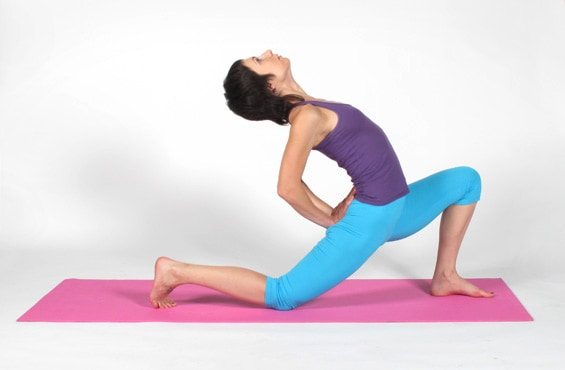
3. The following exercise effectively stretches and trains the muscles of the “front” leg. Do not forget that all poses must be performed evenly: for both the right and left half of the body.
So, lower the leg left behind to the knee, the other leg should remain perpendicular. Place your palms or fists on your lower back and bend back as deeply as possible, throwing your head back or keeping it straight.

4. Take the initial pose: one leg is bent at the knee and thrown forward, the second is stretched back. Place your palms on either side of your “front” leg, fingers facing each other, elbows out to the sides. Stretch your chest toward the floor, making sure it is parallel to the floor surface.
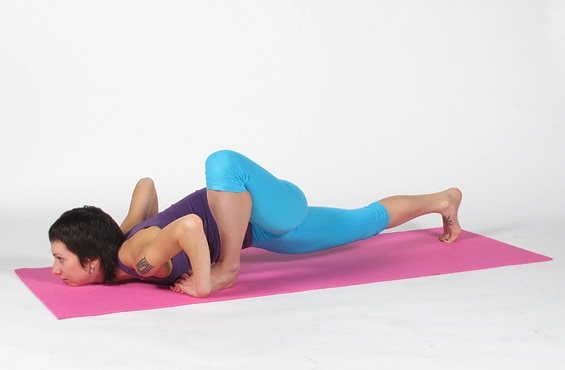
5. Continuation of the previous exercise. From the same pose, try to touch your chest and chin to the floor.
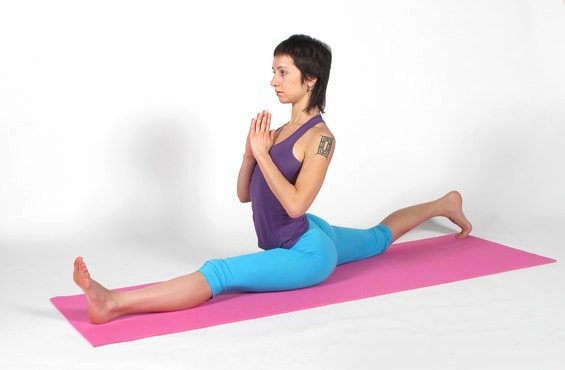
6. Take the main pose again. Bring the knee of your “back” leg as close to the floor as possible, thereby stretching the muscles and warming them up before moving on to the splits. The final pose is a longitudinal split or the maximum possible version of it.
With each workout, you will get closer and closer to the perfect version of the desired pose. At the same time, your muscles and joints will be gently warmed up and trained, putting your body in order.
Warm up before stretching
Before you begin flexibility and stretching exercises, you need to thoroughly “warm up” your muscles and joints. The ideal warm-up in this case would be aerobic exercise that involves the whole body. For example, running, jumping on a plyo box, walking on an elliptical trainer, aerobics.
If you exercise at home, we recommend using the complex burpee exercise. Technique:
- We stand up straight and spread our feet to shoulder level.
- We squat down sharply and lower our palms to the floor in front of us.
- With a jumping movement, we “throw” our hips back and take the “lying support” position.
- We perform classic push-ups from the floor.
- Using the same jumping movement, we pull our hips towards our stomach and immediately jump up.
- During the jump, we stretch our arms towards the ceiling.
Perform all movements one after another, without pauses. Do 2 sets of 10–12 jumps. After this, shake your arms and legs and begin stretching your body.
What you need to know before doing the splits
In fact, 90% of beginners make gross mistakes during their first training, which subsequently result in serious injuries to the joint apparatus with long-term rehabilitation. The list of rules given below will keep you 50% safe if strictly followed.
Powerful muscle warming
Success, stretching pain, injury to unaccustomed muscles, and recovery after training depend on it.
Before you start stretching for the splits, you need to sweat your whole body thoroughly, stretch all your muscles, paying special attention to your legs. For home workouts, jump rope 100 times, squat in two sets of 25 times, do small swings of your legs to the sides and forward 15 times each
If you have weights, work with them - this will pump up your butt and warm up your muscles. The average warm-up time is about 30 minutes, ideally up to 1 hour.
A secret from gymnasts: be sure to wear warm gaiters from the ankle to the knee or slightly higher. Thermal tights or leggings with insulation are also suitable. Warm up until you feel an unrealistic desire to rip off your gaiters from the heat. Only now are the muscles truly ready for stretching into longitudinal and transverse splits. Carry out further exercises in leggings as well. Take them off only after finishing your workout.
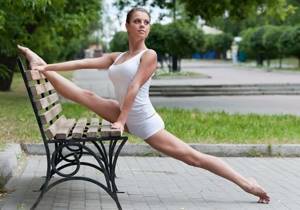
How to stretch correctly: smoothly or jerkily
After watching videos from rhythmic gymnastics training grounds, you can mistakenly conclude that the best stretching is achieved with the help of jerks. Only professional athletes stretch in jerks under the supervision of a coach and medical team. To learn how to do the splits from scratch, you need smooth and slow movements. This way you will feel the level of preparation, the responsiveness of the muscles to stretching, and understand the pain threshold without causing injury.
Girls often ask how they can make smooth swings or jerks to the side, because the names imply sudden movements. At the initial stage, the swings are not made with a mad jerk, but smoothly, with the leg held at the highest point for 2-3 seconds, then slowly lowered without touching the floor or placing the foot in the third dance position.
About the position of the back, stomach and shoulders
Again, girls who are doing stretching for the first time do not maintain the correct position of their back, abdomen and pelvis. Crooked shoulders and a hump between the shoulder blades are not only unaesthetic, but also violate basic rules.
Always watch your posture
Do exercises to do the splits, standing, lying down, sitting - it doesn’t matter. The back is always in line, the head is proudly raised like a ballerina, the shoulders are straightened
Always stretch your stomach towards your thigh, arching your lower back. There is no need to hunch over and try to reach the tips of your toes with your hands or hug your shin due to the hump on your back. Maximum muscle tension when a girl stretches

Don’t worry, not everyone will be able to lie on their stomach at first. However, in a week it is possible.
About the position of the pelvis when stretching into splits
At this point, many mistakes are made that lead to injuries. This is especially true for stretches on the floor in longitudinal splits, where you have to sit on your butt. Gymnasts share advice on how to properly position your buttocks.
Sit on the floor with your legs straight and pointed on your toes. Take your butt with both hands and pull the buns out from under you. The effect will be as if you sat on an ottoman, and your buttocks lie beautifully on the sides. Approximately do the same with your butt as you would adjust your breasts in a bra.
How to do the splits: about breathing
Proper breathing helps relax muscles and psychologically move away from pain by switching attention. When stretching, always take deep breaths through your nose and exhale slowly through your mouth.
If the pain increases, switch your consciousness to your breathing and listen to the sounds of inhalation and exhalation. This is a simple trick that not only athletes, but even gynecologists resort to during childbirth, forcing the woman to breathe.
Should you tense or relax your muscles?
Just relax. Straining while stretching is an inevitable injury. Your muscles should be soft and rag-like. Can't stand the pain? - So the muscles tense voluntarily. Fight with yourself, stretching to the splits is hard work. Don’t believe slogans and stories, I did the splits in 1 day, this is impossible.
What to do with your knees?
At dance lessons, at school in physical education, at gymnastics, at ballet - everywhere they say: “Watch your knees!” Listen up, because bent knees cause untold harm to the tendons and ligaments of the knee and hip joints. If you can’t cope on your own, ask your sister/friend/mother to hold your knees pressed to the floor.
We sit on the cross splits
To master cross splits, do the following exercises:
Place your feet slightly wider than shoulder-width apart and place your hands on your lower back. Slowly bend back, trying to see your heels. If you place your hands on your stomach while doing this, your abdominal muscles will be additionally worked.
Straighten up, place your feet slightly wider than shoulder-width apart and restore your breathing. Then lean forward so that your back is parallel to the floor. Your arms should be extended (for convenience, you can close them in a lock). Look ahead. Spread your legs so that your head and elbows fit between them. Next, bend down and place your palms on the floor. When performing the exercise, do not strain your back or neck. It is also forbidden to bend your knees. Rock back and forth slowly. Perform the previous exercise, but using your forearms. Stretch your arms up, turn your toes out and spread your legs wide. Perform a deep squat. In this case, the back should be relaxed and straight, and the knees should be widely spaced to the sides. Start with 8 sets and increase over time. Take the same pose as in the previous exercise. While squatting, hold for 30 seconds and then rise up
Please note: this exercise may not be easy for beginners. Perform side lunges. When the exercise becomes easy, grab your ankles and reach towards the floor.
Start with 8 sets and increase every 2 weeks.
- Place your legs as wide as possible and lean forward so that your back is parallel to the floor. In this case, you can lean on your elbows. Watch your breathing: the muscles should tense as you enter, and relax as you exhale.
- Do the same as in the previous exercise. Slowly lower your perineum and stomach to the floor. Once this has been achieved, gradually straighten your pelvis, place your feet on your heels and straighten your back.
Stretching at home: effective exercises
Today, stretching has formed into a separate direction, which is becoming increasingly popular, because it has enough advantages. Girls often do it, the main goal of which is flexibility and plasticity of the body, since stretching copes with this very well. Fitness centers offer group stretching classes. But you can also perform stretching and flexibility exercises for beginners and at home. The main thing is to study all the features of such classes.
Stretching: features and benefits
Stretching and flexibility exercises are useful for absolutely everyone: both for ladies who want to become more flexible and graceful, and for male athletes and just people who want to improve their muscles Maintain your health and learn to better control your body. To ensure that the exercises bring maximum benefit and effectiveness, pay attention to the following nuances:
- Stretching is divided into two types: static and dynamic. The point of the first is that you will need to linger in one specific position in order to create the maximum load on the target muscle groups. Dynamic stretching involves making sudden movements. Dynamic load is not recommended for beginners, since with an unprepared body it can provoke sprain and rupture of ligaments and tendons.
- Stretching gives quick results. Once you start exercising, you will soon feel how your muscle strength has increased and your well-being has improved, as the body is actively saturated with oxygen. The figure will become more slender and graceful. And even your skin will become fresher. But, of course, don’t expect that the second time you practice, you’ll be able to do the splits. Obviously, you will become more flexible after about three months of classes.
- You can't do stretching from a state of rest. Flexibility exercises are performed after active warming up of the muscles. You can jump rope, do squats, and do leg swings. And only when you feel that you are sufficiently warmed up, start stretching.
- Stretching exercises can be performed at any time of the day. However, experts believe that the best time for this is evening. Smooth and simple gymnastics will help you calm down and relax after a hard day.
During the exercise, you should only feel tension in the muscles and ligaments, but in no case pain. A sharp, severe pain indicates that something is damaged in the body. Do everything carefully and smoothly, listen to your body and give it time to get used to the loads. If you hear a crunch or click, feel a muscle spasm, dizziness or severe pain, stop exercising.
Nutrition
Proper nutrition will also help you achieve your goals faster and strengthen strained muscles. In this regard, one of the best remedies is fish oil. It is also recommended to add Omega-3 and Omega-6 fatty amino acids to your diet. Consume flaxseed oil, nuts and eggs regularly.
Also an important factor is maintaining water balance in the body. You need to drink at least 2 liters of water per day. Add juicy fruits to your diet. To achieve the desired result faster, stop consuming salt. It can be replaced with seaweed, lemon juice, herbs and natural seasonings.
The list of recommended products also includes:
- carrot;
- nuts;
- spinach;
- meat;
- seafood;
- legumes;
- citrus fruit;
- berries (blueberries, blackberries, cherries and raspberries).
How do the splits?

Effective splits exercises at home include training and stretching your leg muscles. Such exercises promote relaxation and flexibility of muscle fibers.
For beginners, it is better to choose a set of exercises similar in principle to yoga. It is more gentle, smooth and safe. This method will help you relax from the everyday hustle and bustle and achieve maximum results in a short time.
- Before starting your workout, you need to warm up and warm up your muscles.
- Throughout the entire workout, the back should be as straight as possible, and sudden movements should be kept to a minimum.
Ways to do the splits at home - effective exercises:
- Rolls from one leg to the other. We stand straight, feet shoulder-width apart. Bend your right leg at the knee and move your body to the right. Maintain this position for 5-10 seconds, then slowly transfer the weight to your left leg. We hold for the same amount of time. Repeat 25 times.
- Lunges forward. We stand straight, feet shoulder-width apart. The back is straight. Take a wide step forward with your right foot. We try to transfer the weight to it. We stretch our left leg forward as much as possible and lift it. Maintain this position for 10-15 seconds. We return to the starting position. Let's change the position. We repeat it 30 times.
- Bend forward in a sitting position. We sit on the floor. We try to spread the lower limbs as far as possible to the side until there is a complete feeling of tension and tension in the hips. Keep your back straight and try to reach your chest to the floor without bending your knees. We maintain this position for 30-60 seconds.
- Choose a chair or table as a support. We stand straight, about 40 cm from the selected support point. We try to place our right leg on the table (without bending it at the knee) and extend the toe as much as possible. We hold the left one straight, with an even body we try to bend towards the right knee (rest our head against it). Maintain the position for 30-60 seconds. We change legs. The number of repetitions is 20 times.
- We sit on the floor. The back is straight. Bend your knees all the way. We keep our feet together. We press our heels together. We try to spread our knees in different directions (we try to move them as close to the floor as possible). You can use your hands and squeeze your knees with them, pressing them to the floor. It is recommended to maintain the position for 30-60 seconds.
Static stretching
What static stretching is is known to many who at one time wanted to do the splits. In the case of the back, the situation is approximately the same, only with the specifics of the exercises. Below are a few movements that are performed for static stretching.
Without jerking, maintaining a static position.
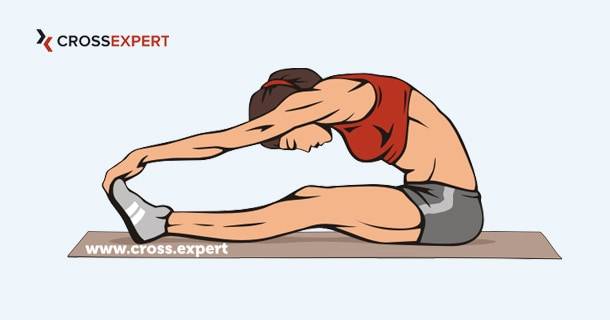
A very useful exercise for your back and overall flexibility.
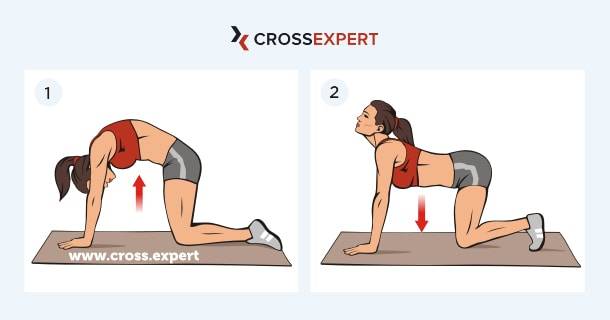
Hanging on the horizontal bar
It would seem that it could be easier than just hanging. Yes and no. Yes, it's easy. No - hanging long enough is not that easy. This exercise helps strengthen your back and grip. Perfectly relaxes the spine after training and a hard day. Track your progress and try to do a little more with each workout. It is optimal to hang for 30 seconds.
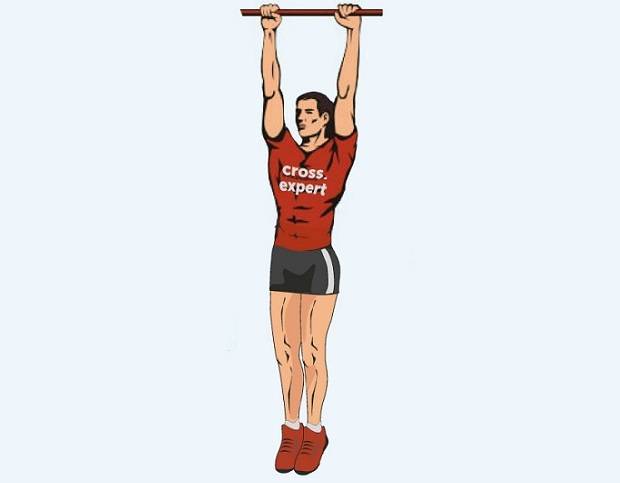
At the counter
- Stand sideways to the counter.
- With one hand that is closer to the counter, grab it, and bring the other one above your head and also grab the counter. Stretch out in an arc from the support.
- Move your pelvis in the opposite direction from the rack.
- Repeat for the other side.

Stretching the lower back muscles
- Sitting on your knees, stretch one leg in front of you, the other behind you and bend at the knees.
- One hand rests its palm on the floor, the other is raised up.
- Lean forward and twist towards your front leg.

Back Extensor Stretch
- We sit on a chair, bend our knees, resting our feet on the floor.
- Grasp the inside of your shins with your palms.
- Leaning forward, round your back. Ideally, you should bend as low as possible.
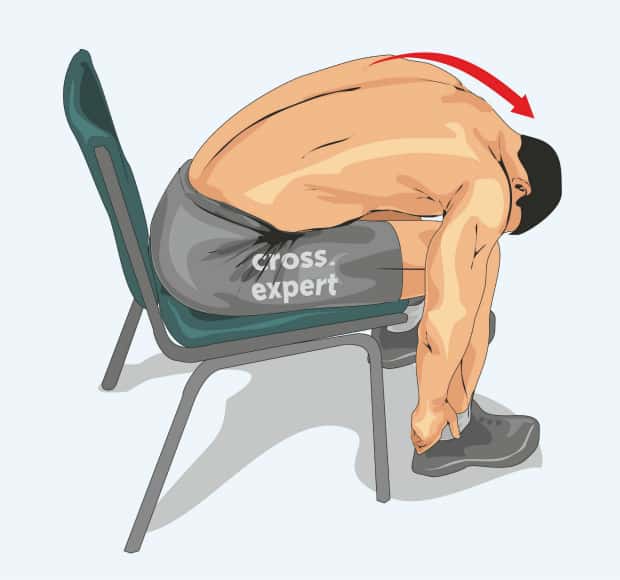
More information about the technique of back stretching exercises can be seen in the following video. An experienced instructor will tell you what mistakes can be avoided, what is best for beginners to start with, and most importantly, how to stretch so as not to harm your athletic achievements.
”alt=””>
